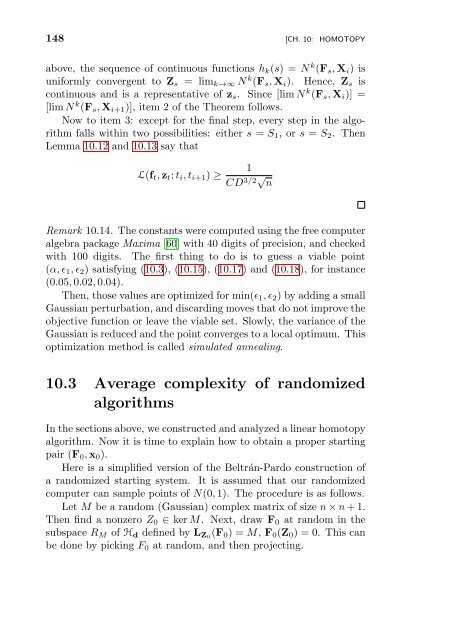Nonlinear Equations - UFRJ
Nonlinear Equations - UFRJ
Nonlinear Equations - UFRJ
You also want an ePaper? Increase the reach of your titles
YUMPU automatically turns print PDFs into web optimized ePapers that Google loves.
148 [CH. 10: HOMOTOPY<br />
above, the sequence of continuous functions h k (s) = N k (F s , X i ) is<br />
uniformly convergent to Z s = lim k→∞ N k (F s , X i ). Hence, Z s is<br />
continuous and is a representative of z s . Since [lim N k (F s , X i )] =<br />
[lim N k (F s , X i+1 )], item 2 of the Theorem follows.<br />
Now to item 3: except for the final step, every step in the algorithm<br />
falls within two possibilities: either s = S 1 , or s = S 2 . Then<br />
Lemma 10.12 and 10.13 say that<br />
L(f t , z t ; t i , t i+1 ) ≥<br />
1<br />
CD 3/2√ n<br />
Remark 10.14. The constants were computed using the free computer<br />
algebra package Maxima [60] with 40 digits of precision, and checked<br />
with 100 digits. The first thing to do is to guess a viable point<br />
(α, ɛ 1 , ɛ 2 ) satisfying (10.3), (10.15), (10.17) and (10.18), for instance<br />
(0.05, 0.02, 0.04).<br />
Then, those values are optimized for min(ɛ 1 , ɛ 2 ) by adding a small<br />
Gaussian perturbation, and discarding moves that do not improve the<br />
objective function or leave the viable set. Slowly, the variance of the<br />
Gaussian is reduced and the point converges to a local optimum. This<br />
optimization method is called simulated annealing.<br />
10.3 Average complexity of randomized<br />
algorithms<br />
In the sections above, we constructed and analyzed a linear homotopy<br />
algorithm. Now it is time to explain how to obtain a proper starting<br />
pair (F 0 , x 0 ).<br />
Here is a simplified version of the Beltrán-Pardo construction of<br />
a randomized starting system. It is assumed that our randomized<br />
computer can sample points of N(0, 1). The procedure is as follows.<br />
Let M be a random (Gaussian) complex matrix of size n × n + 1.<br />
Then find a nonzero Z 0 ∈ ker M. Next, draw F 0 at random in the<br />
subspace R M of H d defined by L Z0 (F 0 ) = M, F 0 (Z 0 ) = 0. This can<br />
be done by picking F 0 at random, and then projecting.

















